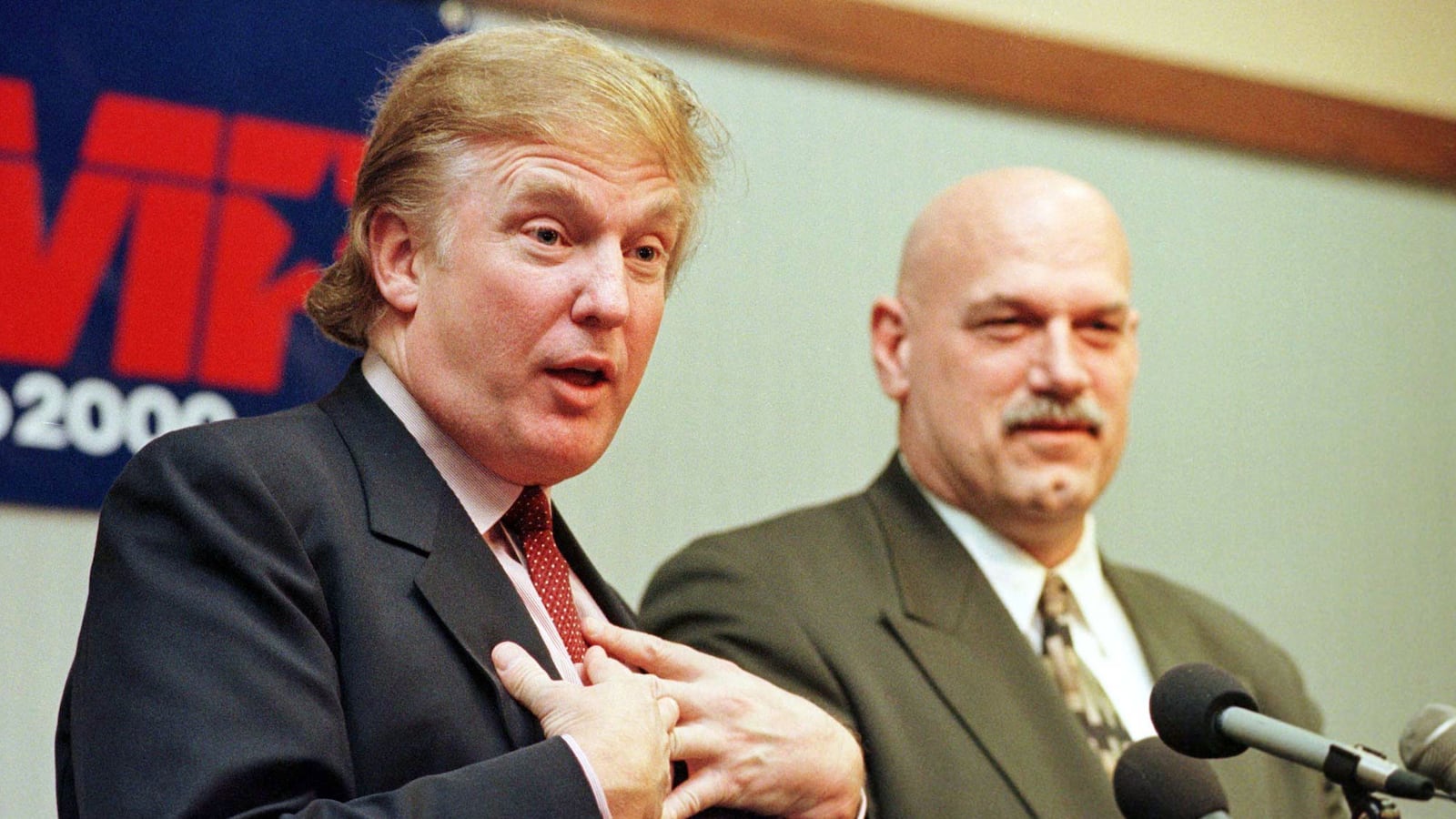Donald Trump says he’s never run for president before, but like much of what he says, that’s not quite true.
In 2000, he actively sought the Reform Party nomination, winning primaries in Michigan and California in the third party founded by Texas billionaire Ross Perot to fight NAFTA (North American Free Trade Act), and promote a balanced budget.
Few people remember the Reform Party and its effort to build a third party around political and economic reform. Voter anger at trade policies and a mounting deficit propelled Perot to briefly top the polls in June 1992, ahead of both incumbent President George H.W. Bush and challenger Bill Clinton.
Anger at trade policies that didn’t deliver the promised jobs had left a lot of Americans hurting, and Trump saw an opportunity for his brand of braggadocio to break through. His rhetoric then was free of the anti-immigrant, exclusionary sentiments that make some Republicans queasy today. He was a political novice then, and he didn’t build a campaign that could go the distance. His candidacy eventually cleared the way for Pat Buchanan, who got the Reform Party nomination only to drive it into the ground.
Trump left the race early citing infighting not “conducive to victory,” but there was more to the story. He had a “liquidity issue” (sounds familiar) and his campaign hinged on whether he sold his casino in Atlantic City.
Trump’s exit from the Reform Party race in February 2000 cleared the way for Patrick Buchanan, right-wing renegade from the GOP, to seize the nomination, which in turn led to the Reform Party’s eventual collapse. Before abandoning the race, Trump wrote in an October 1999 op-ed that Buchanan is “a very dangerous man. …On slow days, he attacks gays, immigrants, welfare recipients, even Zulus. When cornered, he says he’s misunderstood.”
In the end, the Reform Party didn’t win any states, but it got enough votes in ’92 and ’96 to qualify as a national party. Perot’s running mate in ’96, economist Pat Choate, recalled Roger Stone, Trump’s sidekick, “sniffing around” to explore prospects for the 2000 nomination. Trump had Jesse Ventura’s backing. The former professional wrestler, elected governor of Minnesota as a Reform Party candidate, was a visible symbol of what a new, third party could accomplish.
Trump thought he could come in and secure the nomination with the force of his personality. It quickly became apparent he wasn’t willing to do the hard work of getting on the ballot in all 50 states when he failed to field a slate of delegates in New York, his home state.
The media treated Trump’s candidacy like a publicity stunt. His naming of Oprah Winfrey as his dream running mate reinforced the non-seriousness of his effort. He also touted Colin Powell for Secretary of State, John McCain for Secretary of Defense, General Electric CEO Jack Welch for Secretary of Treasury and Congressman Charles Rangel for HUD Secretary, names that defied traditional left-right labeling, which was the point. Trump likes to break new ground.
He hurried into print, “The America We Deserve,” a cornucopia of policy positions touting his opposition to NAFTA, a cornerstone of the Reform Party since Perot famously declared the loud sucking sound Americans hear is jobs going to Mexico. He highlighted his support for gun control and for universal health care, along with his view of social security as a “giant Ponzi scheme.” He said the retirement age should be increased to 70, and that privatization would be “good for all of us.”
He proposed a national lottery to fund anti-terrorism programs, which he hasn’t raised in the current campaign even though terrorism is a much hotter issue now than in 2000.
When asked about his strategy to win the Reform Party nomination, Trump said he would be on TV a lot, and he was, though nothing like today. After he won the California Reform Party primary in March 2000, he wasn’t even a candidate anymore as he declared himself a natural for the presidency.
“ I understand this stuff,” he boasted. “I understand good times and I understand bad times. I mean, why is a politician going to do a better job than I am?”
Choate was among the first academics to warn of the dangers of globalization, and he saw in Buchanan a kindred spirit on trade. Over lunch at the Essex House in New York in September ’99, Choate brought Buchanan together with Lenora Fulani, a left-wing political activist and self-described “post-modern Marxist,” to forge one of the more audacious political relationships in modern times.
“I’m a developmental psychologist and I’m black,” Fulani said in a phone interview with the Daily Beast. “I was interested in gaining access to his blue collar white voters because I’ve always been concerned with that split between the interest of people of color and the white working class.”
They would focus on political and fiscal reform, and Buchanan, no longer a viable presidential candidate as a Republican, readily agreed. He would set aside the cultural issues that had animated his previous runs for the presidency, and on November 11, 1999, he and Fulani stood side by side at the National Press Club, and she endorsed him.
“People were stunned, and I loved it,” she said. “The left said nasty things about me.”
Heartened by letters that poured in from white men around the country, disavowing racism and cheering this new alignment, Fulani was convinced they were on to something. She visited with Buchanan at his home in McLean, Virginia and proposed bringing him to Harlem, where they would walk the streets together and meet with the Rev. Al Sharpton, founder of the National Action Network, at the famed Sylvia’s restaurant.
That was a bridge too far for Buchanan. “He couldn’t, he wouldn’t, he didn’t – I’m not his psychologist,” Fulani recalled. “If we were going to do something to bring together white and black America, it would require some things that are outside of our normal comfort. It was historically important, and for whatever reason, he couldn’t do it.”
Once Buchanan started campaigning to gain ballot access, his voters weren’t about to set aside the divisive social issues they cared about for some vague promises about reform. At a college in Central Illinois, a gay rights group blocked the exits after Buchanan spoke. An aide had to bring his Navigator SUV right to the door to retrieve him. “I said drive across the lawn, and we went flying over the curb,” Buchanan recalled. “I turned to this kid and said, ‘Beats the hell out of going to college!”
By the time of the Reform Party Convention at Long Beach, CA in July 2000, Buchanan had stacked the hall with his people. The Perot Party had become the Buchanan Party. Fulani withdrew her endorsement and walked out of the Convention. Trump was long gone, having had enough impact to lay the groundwork a television career. The first season of “The Apprentice” debuted on NBC in 2004
In the November election, Buchanan got less than a half million votes, fewer votes than he got in the primaries. It was a complete repudiation of social conservatism, says Russ Verney, Reform Party chairman at the time. The party’s philosophy didn’t care whether you were pro-life or pro-choice. “Those were personal missions,” he says. “The Reform Party was Perot’s gift to the people who built it. Unfortunately, it fell victim to a hostile takeover.”
There were 4 states—Oregon, Iowa, New Mexico and Minnesota—where Buchanan drew enough votes to deny Bush the electoral wins that would have avoided the controversy over Florida. After the Supreme Court intervened to hand the election to Bush, Buchanan would riff in his speeches about waking up in a cold sweat having dreamed his gravestone read, “Here lays Patrick J Buchanan. He elected Al Gore.” Distraught, he bargains with God, who agrees he has led an otherwise exemplary life, and steps in to adjust Florida’s ballots.
Because of the improper design of the infamous butterfly ballot, Buchanan got more votes in the heavily Jewish county of Palm Beach than in any other state. The snafu cost Gore the election though Ralph Nader running third party took the brunt of the blame for Gore's loss.
In 2000, Buchanan says he thought there was an opportunity to build a new conservative party. “It was an experiment and it failed,” he says.
In 2016, Trump has that opportunity, and he’s doing it from within the Republican Party with a smorgasbord of loosely framed policies that avoid the cultural issues that have driven GOP politics for so long. Whether he has the discipline and the campaign infrastructure to pull off his hostile takeover is another question.
The voter anger that erupted in ’92 and that led to the Reform Party came from outside the two major political parties, and the issues fueling that anger were successfully co-opted by Bill Clinton, who balanced the budget, by Newt Gingrich with his Contract for America, and by John McCain with campaign finance reform.
The anger this year erupted within the parties, and Trump was savvy enough to see the opening and ride it to the nomination. That’s what he does as a businessman, identify new markets, and push his brand. The bill has come due for a generation cast aside by trade policies that Trump the business mogul benefitted from and that now he wants voters to believe he can fix. The revolution that Perot set in motion in ’92 is back. Everything old is new again.




